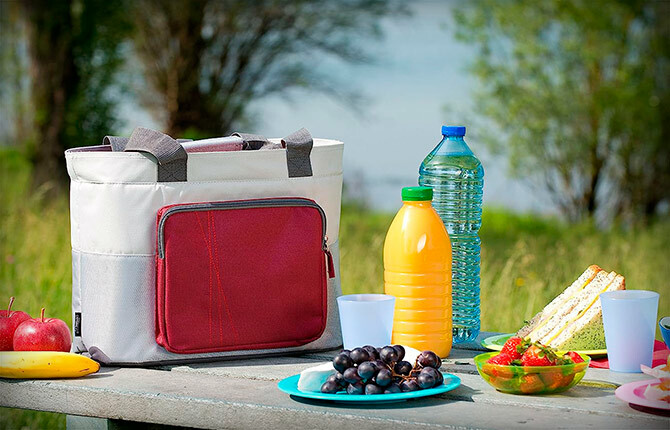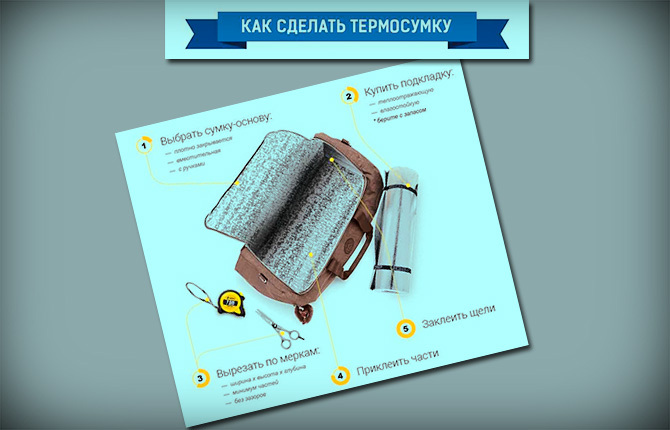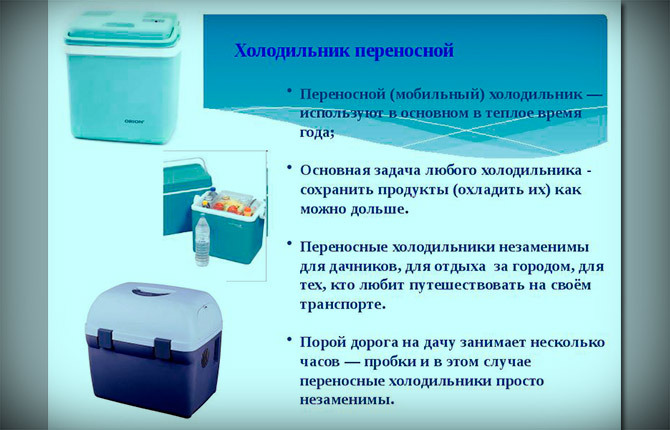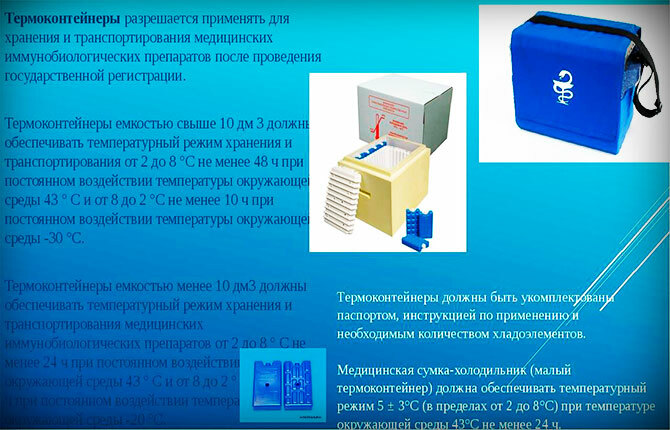The cooler bag is an amazing invention that allows you to keep food fresh, chilled while traveling, picnics or outings. But many ready-made options cost a lot or do not always meet individual needs. In this case, you can make a cooler bag with your own hands.

The content of the article:
- What you need for a cooler bag
-
Do it yourself
- For auto
- Foam option
- For carrying by hand
- Cold accumulators - which one to choose?
- Do-it-yourself cold accumulators
- How to properly operate
What you need for a cooler bag
Making a cooler bag with your own hands is a fun project that will require some materials, tools. Below is a list of the main components that you will need to work:
- Thermal insulation material. The choice of thermal insulation material depends on preferences, financial capabilities. Foiled foam insulation or thermal packaging can be a good option.
- outer material. Choose a durable, waterproof fabric for the outer shell of your cooler bag. Polyester or nylon with a water-repellent coating is perfect.
- Plastic or metal cavities. To create compartments where the refrigeration element will be placed, cavities made of plastic or metal will be required. You can use containers or boxes with lids.
- Coolant. These can be refrigeration batteries, frozen gel packs or special refrigeration units.
- Straps or carrying handles. For the convenience of transporting the cooler bag, it is recommended to provide belts or handles. You can choose the option with Velcro fasteners. Durable nylon or leather handles are also suitable.
- Scissors, thread, needles, glue, tape. To assemble and fasten materials, get various tools, materials to sew a cooler bag.
The manufacture of such a product is a creative process, it is worth preparing mentally for it.
Do it yourself
It is worth figuring out how to make a cooler bag at home for a car, transferring food, drinks manually.

For auto
A cooler bag for a car is a convenient accessory for traveling, long trips or just for storing food while on the move. The table describes step-by-step instructions for creating a refrigerator with your own hands.
| Stage | essence |
| Choice of bag or box | Choose a sturdy plastic box that is large enough to fit in the trunk of your car. The best option is a model with a tight-fitting lid. You can take a strong bag instead of a box. But it must be of a large volume so that you can fill it with products. |
| Insulation | Cover the inside of the box with thermal insulation material. It is recommended to use foil-wrapped foam insulation, which retains the cold well. |
| Refrigeration elements | Insert the cooling elements into the cooler bag. You can use commercial cold accumulators that are designed specifically for cooling in a car. Place them inside the product so that they evenly distribute the cold throughout the space. You can also opt for frozen gel packs or special refrigeration units. |
| Straps or handles for fastening | Provide straps or handles to secure the cooler bag in the trunk of your car. This will ensure a secure fit and prevent movement while driving. |
| Connecting to a car cigarette lighter | If cold accumulators were used, then it is necessary to connect the cooler bag to the cigarette lighter. This will help keep the cold. Make sure that the car is equipped with a constant cigarette lighter power function so that the cooler bag can work even while driving. |
| Pre-cooling, installation | Before traveling or using the refrigerator in a car, pre-cool it by connecting the batteries to the power supply. If frozen gel packs or ice packs are used, place them in the sides of the product after they have cooled down. Then place chilled food. Put the thermal carrier in a convenient place so that it does not get in the way while driving. |

It is recommended to place lighter, softer items on top so that they do not press on more fragile food or cold storage. Separate containers or bags may be used to prevent mixing of odors.
To maximize the cooling time of foods, you can use ice packs or frozen water bottles. They will help maintain a low temperature even during long trips.
Make sure the cooler bag is securely closed to minimize the ingress of warm air.
Foam option
You can make a cooler bag yourself from foam. The steps are described below:
- Preparation of materials. You can purchase Styrofoam from a hardware store or a craft supply store. You will also need a dense material for upholstery of the product (waterproof fabric or plastic shell), a zipper or Velcro to close the bag.
- Case manufacturing. On the foam, mark and cut two identical flat pieces that will serve as the base for the top and bottom of the cooler bag. Also cut four strips of foam for the side walls.
- Assembly. Using glue or other suitable fasteners, connect the side walls to the base of the structure to obtain a rectangular shape. Check that the connections are strong and secure. Then attach the top, making sure it fits well against the sidewalls. Allow the adhesive or fastener time to dry or cure completely.
- Thermal insulation material. Wrap the styrofoam box with layers of thermal insulation material such as foil or isolon. To keep it, you can glue it with adhesive tape to the general structure. Position the cooler element inside the cooler bag ensuring it is evenly distributed.
- Upholstery. Choose a material that will be resistant to moisture, provide additional insulation. Cut it according to the size of the product, fix it on the body of the bag with glue or sewing supplies. First you can create a pattern.
- Creating a lid. Cut off another flat piece of Styrofoam to serve as the lid of the cooler bag. It should be the same size as the top case. Then wrap this flat part with upholstery material. Make sure the lid fits snugly on top of the bag.
- Clasp. Choose a convenient closure method for your cooler bag. It can be a zipper or Velcro. If possible, attach the clasp to the side walls of the bag and the lid. This will allow you to easily open and close the bag while maintaining its internal temperature.
- Testing. Before using the cooler bag, it is recommended to test it to make sure it is effective. Put a small amount of food in the bag, check how long it stays cool. If additional insulation is required, you can add a layer of foam or other insulating materials.

The effectiveness of a cooler bag may depend on the thickness of the foam, the quality of the insulating materials. You can also use penoplex.
For carrying by hand
The hand carry cooler bag is made in the same way as the product for use in the car. The main thing is to choose a durable and waterproof fabric for the outer shell. Polyester or nylon with a water-repellent coating have proven themselves well.
If a person plans to take a bag with him for carrying by hand, then he should worry about the quality of the handles or straps. They must be comfortable.
Tips for sewing on handles:
- determine the optimal location on the side walls of the bag, consider your preferences;
- use strong thread;
- if you want to create adjustable straps, you can use buckles or other fasteners;
- check how well the straps or handles are sewn to the product, especially if it will be used to transport heavy items or large quantities of food.
If there are difficulties, you can watch a video with a master class.
Cold accumulators - which one to choose?
When choosing a cold accumulator for a cooler bag, several important factors should be considered:
- Cooling time. Cold accumulators have different cooling durations. Some can keep the temperature low for several hours, while others can keep the temperature low for several days. Consider your needs, planned usage time to choose the right battery.
- Size, capacity. Cold generators are available in different sizes and volumes. Consider the size and capacity of your cooler bag to choose a battery that will fit and provide adequate cooling inside the bag.
- Battery type. There are several types of cold accumulators. Some are gel-based, others contain a liquid that freezes. Consider the different types, study their characteristics.
- Durability, rechargeable. View information about durability, battery rechargeability. Some models may be rechargeable, which may be more beneficial.

Do-it-yourself cold accumulators
If you want to save money or create a unique cold accumulator, you can try to make it yourself. One popular method is to use frozen gel packs. In this case, you need to follow these steps:
- Place the gel packs in the freezer compartment of your refrigerator. Leave them there for a few hours to completely freeze.
- Once the gel packs are completely frozen, place them inside your cooler bag. Distribute them evenly over the entire area.
Ready-made frozen gel packs can be used as cold accumulators in a cooler bag. They will maintain a low temperature inside the bag, keep food fresh for a certain time.
Frozen gel packs will gradually melt during use. Thus, it will not be possible to keep the cold inside the cooler bag for a long time.
How to properly operate
Simple rules for using thermal transfers, which were made at home:
- Before placing food in the cooler bag, pre-cool it. Place the cold accumulators in the carrier and let them cool down for a while.
- Arrange food in such a way that the cold is evenly distributed. Avoid congestion so that air can circulate freely inside the bag.
- Make sure the cooler bag is completely closed. This will help prevent the penetration of warm air, keep the cold inside.
- Try to avoid frequently opening the cooler bag. Every time you do this, warm air gets inside, causing the temperature to rise, reducing cooling efficiency.
- If possible, further insulate your cooler bag, especially if you are planning long trips. Use thermal blankets or blankets to keep the cold inside.
- Regularly check the cold accumulators for damage, follow the instructions for their use. Proper handling of them will help prolong their service life.
- If you are using a refrigerator in a car, make sure the cigarette lighter will provide constant power. Turn on power saving modes to optimize thermal transfer performance.
- If you have the opportunity, pre-chill the food you are going to put in the cooler bag. Placing already chilled food inside will help lower the temperature, keep the cold for a longer time.
- Try to avoid direct sunlight on the cooler bag. High temperatures from the sun can adversely affect cooling performance. Place the bag in the shade or use a heat shield to prevent heat buildup.
- Be aware of the need to comply with the rules of food storage.

Whether you're opting for the foam option, creating a bag for your car or hand-carrying, it's important to pay attention to the quality of the materials, the insulation, the strength of the connections. Thanks to your own thermo-carrier, you can enjoy fresh food, drinks even on the road, at a picnic or during outdoor activities.
Interesting: How to make the right birdhouse with your own hands
Have you tried to make a cooler bag with your own hands? What difficulties did you face? Tell us about your experience or share your ideas, tips in the comments below. Add this useful article to bookmarks, share with friends on social networks.


